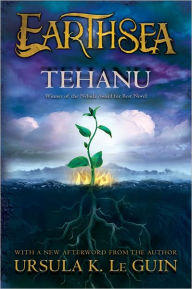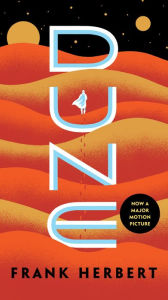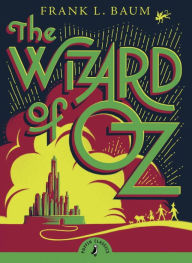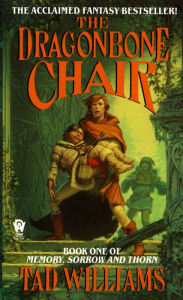7 Epic Fantasies That Grew in the Telling
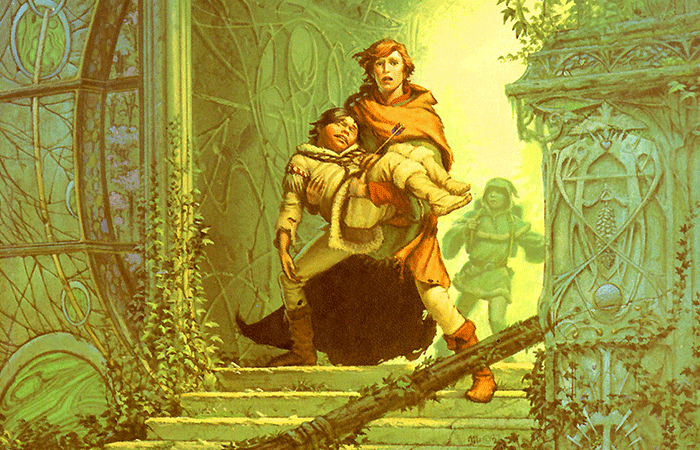 We’ve recently gotten the bad news straight from George R.R. Martin himself: winter won’t be coming, at least, not until well after Game of Thrones‘ sixth season premieres this April. Martin’s been working on The Winds of Winter, the sixth book in A Song of Ice and Fire, since 2011, but the television adaptation charged through five books’ worth of material in as may years, and will officially surge ahead this year.
We’ve recently gotten the bad news straight from George R.R. Martin himself: winter won’t be coming, at least, not until well after Game of Thrones‘ sixth season premieres this April. Martin’s been working on The Winds of Winter, the sixth book in A Song of Ice and Fire, since 2011, but the television adaptation charged through five books’ worth of material in as may years, and will officially surge ahead this year.
But if Martin had stuck to his original plan, Game of Thrones might have already wrapped a three-year run as a miniseries. The scribe’s initial plan was a trilogy, an optimistically short series length in the fantasy genre.
The politics, the environment, the plotlines, the magic—the best fantasies create an entire alternate reality that extends far beyond the binding of a single book. As a result, many epic fantasies worth their fire-breathing salt sprawl so far that they even exceed their author’s expectations, let alone those of the HBO executives depending on them. Here’s a look at seven examples.
George R. R. Martin's A Game of Thrones 5-Book Boxed Set (Song of Ice and Fire Series): A Game of Thrones, A Clash of Kings, A Storm of Swords, A Feast for Crows, and A Dance with Dragons
George R. R. Martin's A Game of Thrones 5-Book Boxed Set (Song of Ice and Fire Series): A Game of Thrones, A Clash of Kings, A Storm of Swords, A Feast for Crows, and A Dance with Dragons
In Stock Online
Paperback $49.95
A Song of Ice and Fire, by George R.R. Martin
Martin pitched A Song of Ice and Fire to publishers in 1993, calling it a trilogy. But, as he was the first to admit in his spoiler-packed pitch letter, he doesn’t outline his novels. “I find that if I know exactly where a book is going,” he explained, “I lose all interest in writing it. I do, however, have some strong notions as to the overall structure of the story I’m telling.” Martin’s “overall structure” is now expected to fit into seven books (though he’s made no hard promises on that front).
The HBO series experienced a similar life extension—though producers originally hoped to end it in seven years, recent behind-the-scenes deal indicate it will probably run to eight seasons, wrapping up in 2018. Freed from production timelines, when Martin will accomplish the same feat is anyone’s guess.
A Song of Ice and Fire, by George R.R. Martin
Martin pitched A Song of Ice and Fire to publishers in 1993, calling it a trilogy. But, as he was the first to admit in his spoiler-packed pitch letter, he doesn’t outline his novels. “I find that if I know exactly where a book is going,” he explained, “I lose all interest in writing it. I do, however, have some strong notions as to the overall structure of the story I’m telling.” Martin’s “overall structure” is now expected to fit into seven books (though he’s made no hard promises on that front).
The HBO series experienced a similar life extension—though producers originally hoped to end it in seven years, recent behind-the-scenes deal indicate it will probably run to eight seasons, wrapping up in 2018. Freed from production timelines, when Martin will accomplish the same feat is anyone’s guess.
Robert Jordan Wheel of Time Boxed Set, Volume 1 (Books 1-3)
Robert Jordan Wheel of Time Boxed Set, Volume 1 (Books 1-3)
Paperback
$20.77
$25.97
The Wheel of Time, by Robert Jordan
Jordan offered the manuscript of the first Wheel of Time book, The Eye of the World, to Tor in the 1980s, and landed a six-book contract for his series as a result. But at that point, it wasn’t even guaranteed to last for six volumes. Tor.com columnist Leigh Butler wrote on the topic last year, reminding her readers that “‘a six-book contract’ is not necessarily the same thing as ‘a contract to write six Wheel of Time books,’ and I’ve definitely gotten the impression from various interviews and such over the years that whether Tor would publish more books in the series was contingent on how TEOTW performed in sales.”
Fourteen books, one prequel novel, and 23 years later, the series finally wrapped up, though the final three books were written by Brandon Sanderson after Jordon passed away in 2007.
The Wheel of Time, by Robert Jordan
Jordan offered the manuscript of the first Wheel of Time book, The Eye of the World, to Tor in the 1980s, and landed a six-book contract for his series as a result. But at that point, it wasn’t even guaranteed to last for six volumes. Tor.com columnist Leigh Butler wrote on the topic last year, reminding her readers that “‘a six-book contract’ is not necessarily the same thing as ‘a contract to write six Wheel of Time books,’ and I’ve definitely gotten the impression from various interviews and such over the years that whether Tor would publish more books in the series was contingent on how TEOTW performed in sales.”
Fourteen books, one prequel novel, and 23 years later, the series finally wrapped up, though the final three books were written by Brandon Sanderson after Jordon passed away in 2007.
Tehanu (Earthsea Series #4)
Tehanu (Earthsea Series #4)
In Stock Online
Paperback $9.99
Earthsea, by Ursula K. Le Guin
Le Guin first stepped into the world of Earthsea with a few short stories, then a trilogy of novels—A Wizard of Earthsea, The Tombs of Atuan, and The Farthest Shore—in 1968, 1971, and 1972, seemingly wrapping up a complete tale. She probably thought she was done with the series, too, as almost 20 years passed before the next Earthsea story.
1990’s Tehanu: The Last Book of Earthsea brought a new angle to the saga by challenging and exploring the implications of the more traditional, quest-focused trilogy it added to. It was also subtitled “the last book of Earthsea,” signalling that Le Guin definitely thought she was done this time. She wasn’t, as a short story collection and a fifth novel proved.
Earthsea, by Ursula K. Le Guin
Le Guin first stepped into the world of Earthsea with a few short stories, then a trilogy of novels—A Wizard of Earthsea, The Tombs of Atuan, and The Farthest Shore—in 1968, 1971, and 1972, seemingly wrapping up a complete tale. She probably thought she was done with the series, too, as almost 20 years passed before the next Earthsea story.
1990’s Tehanu: The Last Book of Earthsea brought a new angle to the saga by challenging and exploring the implications of the more traditional, quest-focused trilogy it added to. It was also subtitled “the last book of Earthsea,” signalling that Le Guin definitely thought she was done this time. She wasn’t, as a short story collection and a fifth novel proved.
Dune
Dune
In Stock Online
Paperback $10.99
Dune, by Frank Herbert*
Herbert spent years crafting his politics and sandworms prior to publishing 1965’s Dune, a self-contained classic. Then he kept adding more.
“Herbert’s Syndrome” was invented specifically for Frank by a 1984 reviewer, between the publication of the fifth and sixth Dune novels. The term’s official definition? When, “a large advance induces a good writer to extend a successful series beyond its natural span.” Whether you agree with the cynicism or not, the term can still be applied, as Frank’s son Brian is still a Herbert and, in collaboration with Kevin J. Anderson, still works within the Dune sandbox.
Dune, by Frank Herbert*
Herbert spent years crafting his politics and sandworms prior to publishing 1965’s Dune, a self-contained classic. Then he kept adding more.
“Herbert’s Syndrome” was invented specifically for Frank by a 1984 reviewer, between the publication of the fifth and sixth Dune novels. The term’s official definition? When, “a large advance induces a good writer to extend a successful series beyond its natural span.” Whether you agree with the cynicism or not, the term can still be applied, as Frank’s son Brian is still a Herbert and, in collaboration with Kevin J. Anderson, still works within the Dune sandbox.
The Wizard of Oz
The Wizard of Oz
By
L. Frank Baum
Illustrator
David McKee
Introduction
Cornelia Funke
Paperback $8.99
Oz, by L. Frank Baum
The Wizard of Oz is, by far, the most famous fantastical kid’s book series named after an “O to Z” filing cabinet. Still, many casual fans have only seen the film, and remain unaware that any follow-ups exist. Author L. Frank Baum even intended the tale to be a stand-alone work.
Somehow, he managed to avoid any accusations of “Baum’s Syndrome,” despite penning thirteen Oz sequels to fix his money problems. Following his death, a handful of authors picked up where Baum left off, writing about the clockwork, porcelain, and pumpkin-headed characters that one would expect to find in Oz. According to the Oz Wiki page, Sherwood Smith’s 2014 release, Sky Pyrates of Oz, marks the 43rd novel in the series.
Oz, by L. Frank Baum
The Wizard of Oz is, by far, the most famous fantastical kid’s book series named after an “O to Z” filing cabinet. Still, many casual fans have only seen the film, and remain unaware that any follow-ups exist. Author L. Frank Baum even intended the tale to be a stand-alone work.
Somehow, he managed to avoid any accusations of “Baum’s Syndrome,” despite penning thirteen Oz sequels to fix his money problems. Following his death, a handful of authors picked up where Baum left off, writing about the clockwork, porcelain, and pumpkin-headed characters that one would expect to find in Oz. According to the Oz Wiki page, Sherwood Smith’s 2014 release, Sky Pyrates of Oz, marks the 43rd novel in the series.
The Dragonbone Chair
The Dragonbone Chair
By
Tad Williams
Foreword by
Morgenes Ercestres
Paperback $9.99
Memory, Sorrow, and Thorn, by Tad Williams
Tad Williams’ pet name for the Memory, Sorrow, and Thorn is “The Bloated Epic,” a reference to the fact that the third novel in the trilogy could not be physically printed in paperback. DAW books was forced to split To Green Angel Tower into two volumes to avoid producing a hefty 1,600-page tome.
Another Williams series, Shadowmarch, underwent the same process, prompting Tad Williams to comment on the reason in one interview: “I have true stupidity in my corner. I keep thinking things will be shorter than they wind up. I only got it right with the Otherland books by making it four volumes in the first place — I’m lucky it didn’t turn out to be five.”
Williams has another shot at producing a mere trinity of books: A sequel trilogy to Memory, Sorrow, and Thorn is in the works, with the first installment expected to come out later this year.
Memory, Sorrow, and Thorn, by Tad Williams
Tad Williams’ pet name for the Memory, Sorrow, and Thorn is “The Bloated Epic,” a reference to the fact that the third novel in the trilogy could not be physically printed in paperback. DAW books was forced to split To Green Angel Tower into two volumes to avoid producing a hefty 1,600-page tome.
Another Williams series, Shadowmarch, underwent the same process, prompting Tad Williams to comment on the reason in one interview: “I have true stupidity in my corner. I keep thinking things will be shorter than they wind up. I only got it right with the Otherland books by making it four volumes in the first place — I’m lucky it didn’t turn out to be five.”
Williams has another shot at producing a mere trinity of books: A sequel trilogy to Memory, Sorrow, and Thorn is in the works, with the first installment expected to come out later this year.
Debug Notice: No product response from API
Mistborn, by Brandon Sanderson
This list wouldn’t be complete without Sanderson, the poster child for prolific authors of stunning epics. While Martin and Le Guin may have expected their series to be trilogies at first, Sanderson one-ups them: He first pitched his Mistborn series as a trilogy of trilogies: a medieval trilogy, a 1980s-era modern trilogy, and a future-set sci-fi trilogy would all feature the same metallurgy-based magic system.
Sanderson couldn’t constrain himself to nine books, though, and wrote another series, Wax and Wayne, set in a time period correlating with the late 19th century in America—or, roughly, somewhere between entries one and two on his original list. The third Wax and Wayne book, The Bands of Mourning, is out this month, but Sanderson has a fourth one planned, bringing the total number of released or planned Mistborn books to thirteen. So far.
*Yes, I know Dune is technically science fiction. I say it’s also fantasy. There’s some back-and-forth on the subject. If you disagree, you may pick up your pitchfork in the comments.
Mistborn, by Brandon Sanderson
This list wouldn’t be complete without Sanderson, the poster child for prolific authors of stunning epics. While Martin and Le Guin may have expected their series to be trilogies at first, Sanderson one-ups them: He first pitched his Mistborn series as a trilogy of trilogies: a medieval trilogy, a 1980s-era modern trilogy, and a future-set sci-fi trilogy would all feature the same metallurgy-based magic system.
Sanderson couldn’t constrain himself to nine books, though, and wrote another series, Wax and Wayne, set in a time period correlating with the late 19th century in America—or, roughly, somewhere between entries one and two on his original list. The third Wax and Wayne book, The Bands of Mourning, is out this month, but Sanderson has a fourth one planned, bringing the total number of released or planned Mistborn books to thirteen. So far.
*Yes, I know Dune is technically science fiction. I say it’s also fantasy. There’s some back-and-forth on the subject. If you disagree, you may pick up your pitchfork in the comments.


